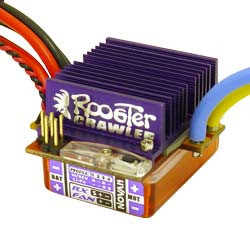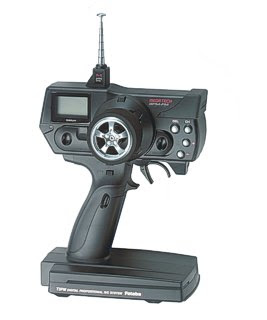This project is being funded in large part by the sale of unwanted motorcycle parts. I've sold a pair of 1970's Suzuki GT250 fork legs for £39.99 this week, so this was my basic budget for a pair of motors. Suitable 540 size motors for a Clodbuster/Clodzilla project come in a lot a variations with regard to the winding turn count - the stock motors are reported to be either 23 or 27 turns, with lower turn counts giving higher RPM and higher counts giving greater torque at the price of much lower peak RPM. Typical values here (for Team Atlas Rock Climber Motors) are: 40T 11000RPM, 60T 8030RPM, 70T 6700RPM, 80T 5940RPM, 90T 4730RPM and 100T 3850RPM.
Purist rockcrawling motors have turn counts running up to about 110 turns, but this is far too extreme for me, what with the 10 tooth pinions I have bought this would give me a top speed far less than walking pace, maybe as low as 1 1/2 or 2mph.
My design criterion requires motors in the 35-50 turn range (being as my ESC has a rating of anything down to two 35t motors), and the budget was £20 tops for each motor. This narrowed the field down to about four final choices:
Atomic (various turns):

$21.00 each (£12.75) + $16.00 P+P (from San Gabriel, California).
Venom Fireball 50:

£17.99 each + £2.00 P+P (from West Yorkshire).
Integy 45t:

$17.99 (£10.92) each for the V10 version, $33.99 (£20.64) (discounted from $37.99) + $9.84 (£5.96) P+P for the V11 (from Salt Lake City, Utah)
Final choice - Tamiya 35t (54114):

£39.00 + £2.00 P+P each here in the UK; or $23.95 (£14.54) + $7.50 P+P from Hong Kong. (You can guess which I choose!)
The blurb says:
"When rock crawling, it is very important to have a motor that provides the appropriate amount of torque required, to give you more control over the vehicle. Tamiya is releasing the CR-Tuned Motor (35T) to meet the needs of all Rock Crawlers."
"This CR-Tuned Motor (35T) is perfect for rock crawing machines that run at low-speeds and need precise acceleration inputs."
The specifications say:
For: CR-01 Chassis Vehicle, Big Tire Trucks, Touring Cars and M-Chassis Vehicles
MAX RPM is reduced to focus on increased torque.
Features smooth power transfer and long endurance.
Black motor body with an end bell that acts as a heat sink.
0 Degree lead angle for consistent performance.
(Meaning I don't have to reverse the direction of the rear motor to suit the Clodbuster configuration.)
Replaceable standard type brushes.
Turns: 35T
Voltage: 7.2V
RPM when not loaded: 12,000 RPM (7.2V)
Motor Size: 540
Gear Ratio: 32.4~50.6
Max. Torque: 36.7mN-m (7.2V)
I hope they are good. Everything just about stops now for a couple of weeks until they arrive. I may well have a go at making skid plates for the gearboxes and under the centre body in the meantime. Back to the workroom benches we go...










































































